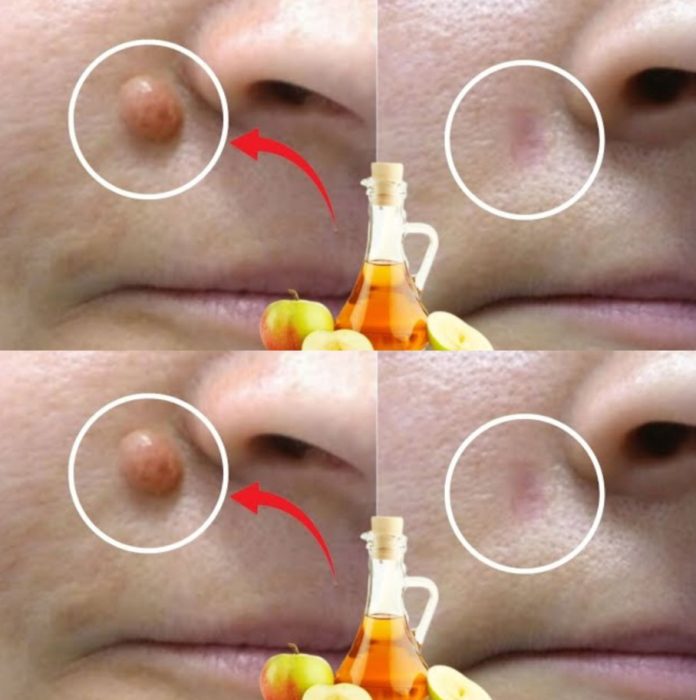Warts can be an annoying and embarrassing skin condition that many people face. These small, harmless growths are caused by the human papillomavirus (HPV) and can appear on any part of the body. While they usually don’t pose a serious health risk, warts can sometimes be painful or cause discomfort, especially when they are located in places like the soles of the feet or fingers.
Fortunately, nature has provided us with a simple, effective remedy that can remove warts quickly: apple cider vinegar (ACV). This humble kitchen staple has gained popularity for its ability to eliminate warts in as little as 24 hours. In this article, we’ll explore why apple cider vinegar is so effective against warts and guide you through the steps to use it for fast results.
Understanding Warts: What Are They?
Warts are benign skin growths caused by the human papillomavirus (HPV), a virus that infects the top layer of skin, causing rapid growth and forming the small, rough bumps we know as warts. They can vary in appearance depending on their location and the strain of HPV causing them. Common warts usually appear on the hands and fingers, plantar warts develop on the soles of the feet, and flat warts can appear on the face or legs. While warts are not typically harmful, they can spread to other parts of the body or to other people through direct contact, making them a nuisance for those who have them.
What Makes Apple Cider Vinegar So Special?
Apple cider vinegar has been celebrated for its health benefits and therapeutic properties for generations. This vinegar is made from fermented apple juice, and its key active ingredient, acetic acid, is responsible for its powerful antiviral, antibacterial, and antifungal properties. Acetic acid can help break down the wart tissue and stimulate the immune system to fight off the HPV virus. Furthermore, apple cider vinegar’s anti-inflammatory properties make it an ideal natural remedy for soothing skin irritations and reducing the discomfort associated with warts.
The Power of Acetic Acid: The acetic acid in apple cider vinegar works to exfoliate the skin, removing dead skin cells and gradually breaking down the wart. This acidic environment makes it difficult for the HPV virus to thrive, effectively stopping the wart from growing.
Antiviral and Antibacterial Effects: Apple cider vinegar’s ability to combat viruses and bacteria is well-documented. When applied to a wart, it can help to eliminate the virus that caused the growth, preventing the spread of warts to other areas.
Using Apple Cider Vinegar for Wart Removal: Step-by-Step Guide
If you’re ready to try apple cider vinegar for wart removal, follow these simple steps to ensure you get the best results:
Materials You Will Need:
- Apple cider vinegar
- Cotton ball or cotton pad
- Adhesive bandage or medical tape
Instructions:
- Prepare the Area:Begin by thoroughly cleansing the skin around the wart with warm water and mild soap. This will help remove any dirt and oils that may interfere with the treatment. Once the area is clean, gently pat it dry with a clean towel.
- Soak the Cotton Ball:Take a cotton ball or cotton pad and soak it in apple cider vinegar. Make sure the cotton is saturated but not dripping to avoid excess vinegar on the surrounding skin.
- Apply the Vinegar:Place the soaked cotton directly on the wart, ensuring it covers the entire area. Use an adhesive bandage or medical tape to secure the cotton in place, preventing it from moving around or falling off.
- Leave It On:Keep the vinegar-soaked cotton on the wart for at least 24 hours. For best results, replace the cotton with a freshly soaked piece every few hours to maintain the effectiveness of the treatment.
- Check the Progress:After a day, remove the cotton ball and examine the wart. You should notice that it has started to darken and shrink, a sign that the vinegar is working to break down the wart tissue.
- Repeat as Necessary:If the wart has not completely disappeared after 24 hours, continue the treatment for another day or two. Reapply the vinegar-soaked cotton until the wart is gone.
Tips for Maximizing Results
- Protect Surrounding Skin: Apple cider vinegar is acidic and can cause irritation to the skin around the wart. To protect your skin, apply a thin layer of petroleum jelly or a thick moisturizer around the wart before applying the vinegar.
- Monitor for Irritation: If you experience any severe discomfort, redness, or irritation, discontinue use immediately and consult a healthcare professional.
- Patience and Consistency: While apple cider vinegar can work quickly, it’s important to be patient and consistent with the treatment. Some warts may take a little longer to respond, depending on their size and location.
Why Choose Apple Cider Vinegar?
Natural and Safe Solution: Unlike chemical treatments or invasive procedures, apple cider vinegar offers a natural and gentle alternative for wart removal. It allows you to avoid harsh chemicals that might damage the skin.
Affordable and Accessible: Apple cider vinegar is widely available and inexpensive, making it an economical choice for those seeking a home remedy for warts.
Proven Effectiveness: Many people have found relief from warts using apple cider vinegar, with numerous testimonials attesting to its effectiveness in reducing and eliminating warts.
Conclusion :
Apple cider vinegar is a powerful, natural remedy that can effectively remove warts with its antiviral and antibacterial properties. By following the simple steps outlined above, you can harness the healing power of apple cider vinegar to safely and efficiently eliminate warts, sometimes in as little as 24 hours. With its affordability, accessibility, and proven results, apple cider vinegar is an excellent choice for those looking to get rid of warts without resorting to harsh chemicals or medical treatments.
Celebrate your journey to clear, radiant skin with the natural healing properties of apple cider vinegar. Say goodbye to warts and hello to smooth, healthy skin!
Source of the picture : Barbara O’Neill Lectures










